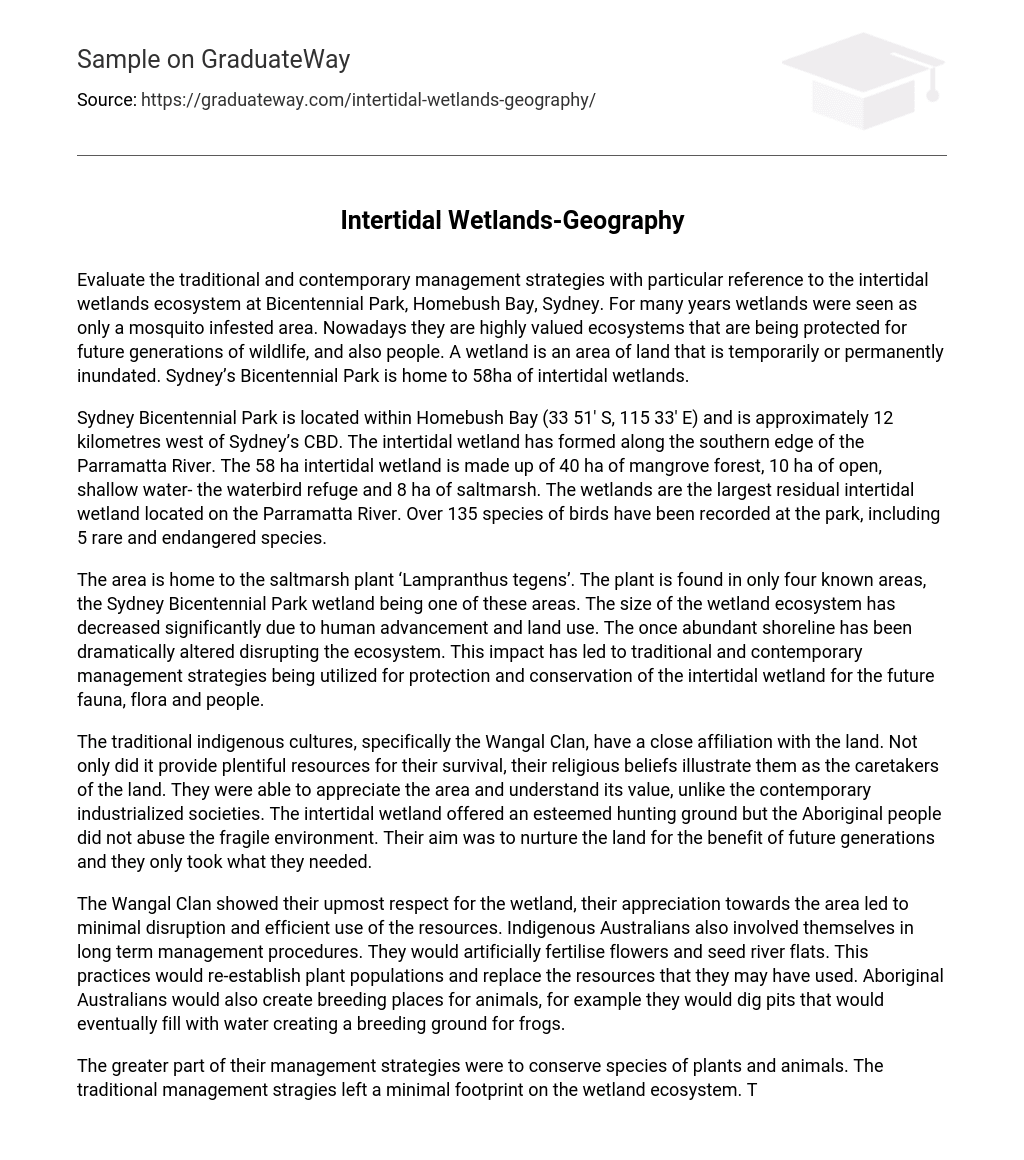Evaluate the traditional and contemporary management strategies with particular reference to the intertidal wetlands ecosystem at Bicentennial Park, Homebush Bay, Sydney. For many years wetlands were seen as only a mosquito infested area. Nowadays they are highly valued ecosystems that are being protected for future generations of wildlife, and also people. A wetland is an area of land that is temporarily or permanently inundated. Sydney’s Bicentennial Park is home to 58ha of intertidal wetlands.
Sydney Bicentennial Park is located within Homebush Bay (33 51′ S, 115 33′ E) and is approximately 12 kilometres west of Sydney’s CBD. The intertidal wetland has formed along the southern edge of the Parramatta River. The 58 ha intertidal wetland is made up of 40 ha of mangrove forest, 10 ha of open, shallow water- the waterbird refuge and 8 ha of saltmarsh. The wetlands are the largest residual intertidal wetland located on the Parramatta River. Over 135 species of birds have been recorded at the park, including 5 rare and endangered species.
The area is home to the saltmarsh plant ‘Lampranthus tegens’. The plant is found in only four known areas, the Sydney Bicentennial Park wetland being one of these areas. The size of the wetland ecosystem has decreased significantly due to human advancement and land use. The once abundant shoreline has been dramatically altered disrupting the ecosystem. This impact has led to traditional and contemporary management strategies being utilized for protection and conservation of the intertidal wetland for the future fauna, flora and people.
The traditional indigenous cultures, specifically the Wangal Clan, have a close affiliation with the land. Not only did it provide plentiful resources for their survival, their religious beliefs illustrate them as the caretakers of the land. They were able to appreciate the area and understand its value, unlike the contemporary industrialized societies. The intertidal wetland offered an esteemed hunting ground but the Aboriginal people did not abuse the fragile environment. Their aim was to nurture the land for the benefit of future generations and they only took what they needed.
The Wangal Clan showed their upmost respect for the wetland, their appreciation towards the area led to minimal disruption and efficient use of the resources. Indigenous Australians also involved themselves in long term management procedures. They would artificially fertilise flowers and seed river flats. This practices would re-establish plant populations and replace the resources that they may have used. Aboriginal Australians would also create breeding places for animals, for example they would dig pits that would eventually fill with water creating a breeding ground for frogs.
The greater part of their management strategies were to conserve species of plants and animals. The traditional management stragies left a minimal footprint on the wetland ecosystem. Their methods were sustainable as they would replace the resources they’d use. The value of intertidal wetlands has become known only very recently. The lack of knowledge and ignorance of past generations, more notably developers, has led to substantial disruptions in the local ecosystem. The building of bund walls has had a significant effect on the hydrology of the site as it has modified the flow of water.
The change in flow reduced the amount of water getting to the mangroves and soil moisture in mangroves has decreased. The establishment of bund walls has ultimately led to destruction of the wetlands; in particular Wentworth Bay which no longer exists. A contemporary strategy to allow the ecosystem to return to its initial state is the removal of the bund walls. Though the removal of bunds walls is of high cost, the final result of having the original flow of water reinstated is influential. The atmosphere in the intertidal wetland plays a significant role in the interactions of the biophysical environment.
The construction of non-linear walkways minimizes disturbances to the canopy and decreases wind channeling often seen with linear walkways. The erection of walkways has also created a designated path to control the access to the ecosystem. There has been a massive reduction in disturbance of the area and the pathway protects the mangroves from unnecessary destruction. However, these wooden pathways are high maintenance and a low life span. The majority of the public are unaware of the importance of wetlands. Education campaigns have been influential in changing public perception and support for the preservation of the wetlands is increasing.
Bicentennial Park provides education programs that include guided tours of the wetland to the public. As a contemporary management strategy education enables the public to realize the vital need to protect the wetlands. They are informed by information officers, education officers and field staff about the steps they can take to contribute to looking after the wetlands. The effectiveness of this contemporary management strategy is reasonably high. The involvement of the public is enormously important for the conservation of the Bicentennial Park wetlands.
Human impacts on the Bicentennial intertidal wetlands have decreased as we become more knowledgeable of the importance of this ecosystem. Traditional and contemporary management strategies are utilized to conserve and protect the area. The genetic diversity of intertidal wetlands should be cherished and looked after. The contemporary management strategies have fought to combat the past negative impacts concerning the intertidal wetlands. These strategies were predominantly successful in preserving and conserving the genetic diversity of the Bicentennial Park intertidal wetland.
The Wangal Clan’s traditional management strategies allow an appreciation and understanding of the land. Their religious ties to the area give them a responsibility to care for the land that provides them the ability to live. After all the damage made in the past, the traditional and contemporary ecosystem management strategies of the Bicentennial intertidal wetland ecosystem are proving to encourage growth and repair. The conservation and sustainability of the land have consequently saved the ecosystem, though there is still a long way to go, the ecosystem has been salvaged for the future.





